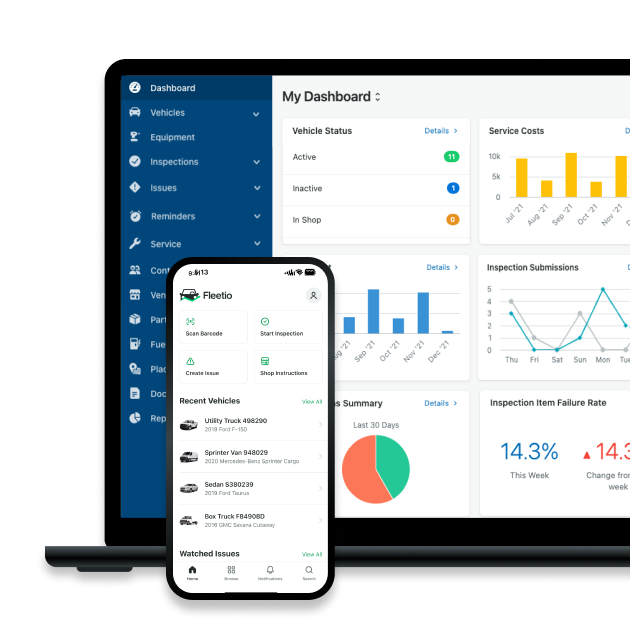What is an inventory reconciliation?
May 10, 2023
5 min read
Inventory reconciliation is a common best practice for many operations, but it can be particularly important for fleets. Here’s what you need to know about inventory reconciliation, how to do it, and how it can improve your fleet.

What is Inventory Reconciliation?
Inventory reconciliation is a vital process for parts inventory management and fleet reporting. It involves checking inventory records and comparing how much of each part you purchased versus what you physically have left in storage. As you use the parts for regular maintenance and repairs, you should be effectively keeping an inventory of how much you’ve used, and when you conduct a reconciliation, you’re essentially closing the gaps in your inventory that may develop over time.
The actual process entails physically counting all of the components of your inventory, cross-referencing it against your record and adjusting or correcting as needed. Many fleets use parts inventory management software and other technologies like barcode scanners and RFID tags to conduct their reconciliations, but for fleets strapped for resources, an inventory management spreadsheet can be just as effective if you’re attentive.
Why is Inventory Reconciliation Important for Fleet Management?
Having well managed inventory data is especially important for fleets that manage their own maintenance in-house. Not having the necessary parts on hand impacts the downtime required to service your fleet vehicles, which in turn impacts your overall productivity. If you run out of certain parts, there’s no guarantee that you’ll be able to reorder and receive them in a timely manner, which could mean significant delays for your operation.
Additionally, if you find yourself on either end of the parts spectrum, either constantly reordering in a panic or always overstocked, you could be losing money. Having too many parts on hand could tie up your capital in storage and handling costs, and having too little means you might not be able to make the best purchasing decisions when you need to reorder.
Having accurate inventory records is also a general inventory best practice, and an important part of accountability within your fleet. Reconciliations mean you get to quickly identify any discrepancies or errors in your inventory records and then find quick solutions to the problem, whether it’s a breakdown in your inventory processes or an oversight in maintenance.
How Can Fleets Use Inventory Reconciliation to Improve Their Operations?
-
Ensure Accurate Inventory Levels – Accurate inventory levels help fleet managers order the right parts and supplies in time, ensuring that the necessary resources are available when needed, helping increase uptime, avoid delays and keep down costs.
-
Identify and Correct Errors and Discrepancies – If your recorded inventory doesn’t match your physical inventory levels, you can use a reconciliation to gauge issues like incorrect records, theft or damage.
-
Reduce Inventory Carrying Costs – Maintaining accurate inventory levels and avoiding overstocking can help fleet managers reduce inventory carrying costs, which frees up money and resources that can be used for other budget items, like maintenance, repairs, or upgrades.
-
Improve Operational Efficiency – By maintaining accurate inventory records, fleet managers can find trends in their parts usage, which lets fleets optimize their inventory levels, reduce waste, save money and improve efficiency over time.
Track your parts and inventory with Fleetio!
Start a free trialHow to Conduct an Inventory Reconciliation and Resolve Discrepancies
Discrepancies can show up in inventory reconciliations from time to time. If you’re doing reconciliations regularly, you’ll generally be able to avoid most discrepancies, but knowing how to recover from a discrepancy is just as important as avoiding them. Here are some steps that can be taken to resolve inventory discrepancies:
-
Conduct a Physical Inventory Count – The first step in resolving an inventory discrepancy is to conduct a physical inventory count to figure out what your current inventory numbers are. This should be completed by a trained and authorized employee to ensure accuracy.
-
Compare Physical Count with Inventory Records – Once you know your current inventory numbers, you’ll need to compare those numbers with your inventory records. Make sure you account for all work orders during the period of time you’re analyzing so you know how many parts were intended to be used in regular service, and identify anything that differs from those numbers as a discrepancy.
-
Identify the Cause of Discrepancy – Figure out what caused the discrepancy, which could stem from things like work order errors, miscounts, damage or even theft. Review transaction records, inspect for damage, and consult employees who were involved in handling the inventory.
-
Make Necessary Adjustments – Once you’ve determined what caused the discrepancy, adjust your inventory records to accurately reflect the current standing of your inventory and amend historical data to correct for any miscounts if you can.
-
Implement Controls to Prevent Future Discrepancies – You’ll want to put a plan in place to avoid any future discrepancies. Implement new procedures or edit existing measures for receiving and storing inventory, and of course, continue conducting regular physical inventory counts. If you’ve incurred any damage or theft, intentional or accidental, be sure you take the proper steps with your staff to ensure it won’t happen again.
-
Review and Monitor Inventory Levels Regularly – To ensure that inventory levels remain accurate, it is important to review and monitor inventory levels regularly. This can involve conducting regular physical inventory counts, reviewing transaction records, and analyzing inventory usage patterns to identify any potential issues.
Using Fleet Management Software to Manage Inventory
The best way to avoid any major surprises in your inventory reconciliations is to effectively manage your parts and inventory with a fleet management platform like Fleetio. Automated features allow you to integrate your inventory and work order processes, so as parts are added to services, your online inventory is automatically updated based on work order criteria.
Need a better way to track your parts and inventory? Get a free trial or request a demo today.

Senior Fleet Content Specialist
As a Senior Fleet Content Specialist at Fleetio, Peyton explores the voices and experiences that shape fleet operations. She focuses on how fleet professionals adopt technology, improve efficiency and lead their teams to bring clarity and context to the challenges happening across the industry.
View articles by Peyton PanikReady to get started?
Join thousands of satisfied customers using Fleetio
Questions? Call us at 1-800-975-5304
